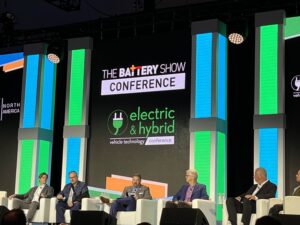Industry leaders’ insights on the future of battery materials supply and production
At The Battery Show (Oct. 6–9; Detroit, Mich.), all eyes were on the supply chain, with wide-ranging panel discussions covering everything from emerging technologies to reduce the reliance on certain metals and the importance of supporting startup companies, to the absolute criticality of adopting long-term investment strategies in battery manufacturing at a federal level to support competitiveness on the global scale.
Obviously, continuing innovations in materials science and novel battery chemistries seem poised to help alleviate some supply-chain challenges and help expand battery production. But advances in manufacturing, including the deployment of high-performance robotics and artificial intelligence (AI) will also be critical.

Keynote panelists at The Battery show
LFP supply chain expands globally
A common theme at The Battery Show was the diversification of raw-material supply in the wake of China’s significant dominance and restrictive trade activities. China has traditionally been seen as the only mainstream producer of precursors for lithium iron phosphate (LFP) cathode materials, but LANXESS AG (Cologne, Germany) entered the LFP market in 2024, becoming the first Western producer of key LFP precursor materials, which can be used for two different LFP production processes.
While its iron oxide battery grades are already used in industry, LANXESS has started to build up new production capacities for iron phosphate. The aim is for greater independence and secure supply to the European and American markets with sustainable materials of local origin.
“There’s really no Western supplier for iron oxide and iron phosphate battery grades outside of China with sufficient capacities to serve the market. Our precursor materials are complete free of Chinese value chains because we are sourcing and supplying all the raw materials locally for our sites in Europe and Brazil. Our iron phosphates and iron oxides are already field-proven, and so is the alternative route for the manufacture of LFP. We believe that both materials will have their own position or standing in the market, because they generate LFP with different performance properties for the end customer,” says Murat Gürsoy, head of innovation at LANXESS.
LANXESS’ significant advantage in LFP supply chain is its global manufacturing network, especially for iron oxide products. LANXESS currently operates a world-scale synthetic iron plant in Germany, which feeds the iron phosphate and iron oxide production infrastructure. This enables liberation from traditional supply-chain concerns, as well as the use of a unique production method that enables the production of higher-performance LFP grades without the common supply concerns.
“The mainstream iron phosphate manufacturing process used in China generates 1 ton of neutral salts for every ton of iron phosphate, and they have to get rid of these waste salts. Since our process starts with metallic iron rather than iron salts, and we can use our existing iron-oxide manufacturing assets, we can generate nearly zero waste. The only byproduct we are generating is hydrogen offgas,” explains Gürsoy.
LANXESS’ foray into the LFP supply chain started about three years ago with some publicly funded research and development work in Germany to produce LFP based on different iron oxide materials at the lab and pilot scales. “We had to evaluate the LFP on an electrochemical level to determine which properties were most important for our precursor materials, and we had to look at how iron oxide can be processed in the LFP manufacturing process,” notes Gürsoy.
LANXESS’ slate of iron oxides suitable for cathode active materials span a range of particle geometries (octahedral, spherical and needle) across the spectrum of iron oxide compounds. “With our synthesis methods, we can deliver a range of morphologies. Different shapes have different advantages within the LFP manufacturing process,” he adds.
For the next generation of cathode active materials, LANXESS plans to tackle end users’ raw-material security concerns by investigating the use of waste streams in the manufacture of iron products. “For example, for the synthesis of the iron oxide grades, we can use iron scrap coming from the automotive industry. It’s really challenging to use iron scrap, because the automotive industry covers the iron with zinc as an anti-corrosion inhibitor, and we are developing solutions to offer precursor materials with 80% recycled content. These are ongoing investigations related to our precursor materials that we are carrying out,” says Gürsoy.